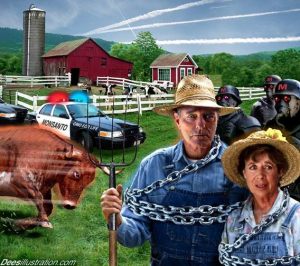R-CALF United Stockgrowers of America
“Fighting for the U.S. Cattle Producer”
For Immediate Release
Contact: Shae Dodson-Chambers, Communications Coordinator
October 14, 2009
Phone: 406-672-8969; e-mail: sdodson@r-calfusa.com
Op-Ed by R-CALF USA Animal ID Committee Chair Kenny Fox**
It Appears NAIS Enforcement Gets Underway in Wisconsin
Billings, Mont. — It appears that in the state of Wisconsin, which has mandated the first prong of the U.S. Department of Agriculture’s (USDA’s) National Animal Identification System (NAIS) through agency rule making, prosecution of individuals opposed to NAIS has begun.
On Sept. 23, 2009, an Amish gentleman named Emanuel J. Miller, Jr., was taken to Clark County Court in Neillsville, Wis., for an evidentiary hearing on complex civil forfeiture for failing to register his premises. The case immediately moved to the first stage of trial. Miller and his father, as well as their church deacon, testified as to their objections to being forced to use the NAIS premises identification number (PIN). As USDA has proudly proclaimed in many glossy brochures, premises registration is the “first step” in the NAIS, and the Wisconsin Amish have become quite aware of this.
On Oct. 21, 2009, in Polk County, Wis., R-CALF USA Members Pat and Melissa Monchilovich are going to trial for the same charges of complex civil forfeiture. Pat and his wife raise cattle in Cumberland, Wis., and have failed to register their property as a premises with the Wisconsin Department of Agriculture and Consumer Protection, as Wisconsin’s Department of Agriculture, Trade and Consumer Protection (DATCP) requires by regulation.
This is the tip of the NAIS iceberg. One could look upon Wisconsin as the sentinel case in the enforcement measures necessary to bring this nation’s citizens into compliance with NAIS.
Although the statute that enables Wisconsin’s DATCP to require premises registration does indeed allow for exemptions, when DATCP wrote the regulations, it decided to disallow any exemptions. This is a major issue, particularly with the Amish community (and others) who hold religious objections to the NAIS.
At the Miller hearing, the Amish said that although they cannot state with absolute certainty that the NAIS’ premises identification number is the precursor to the “Mark of the Beast,” they do know it is the first step of NAIS that leads to the individual numbering and tracking of animals. The Amish said they believe caution is in order to avoid discovering later that they had violated their beliefs and then have no recourse to remedy that error. Their religious objections to obtaining an NAIS PIN are real and personal.
Despite a desire on the part of proponents of NAIS to negate religious objections to NAIS, the fact that it is a global program is indisputable, as enforcement measures and final details are left up to member nations of the World Trade Organization (WTO). In Australia*, rancher Stephen Blair was fined a total of $17,300 for using the wrong tags on 177 of his cattle. Notably, the components of Australia’s National Livestock Identification System (NLIS) are the same as those in NAIS.
In March 2007*, another case in which the identification of cattle was in violation of the identification mandate to facilitate global trade happened the United Kingdom (UK). Dairy farmer David Dobbin had an unspecified number of cattle whose tags didn’t match their “passports.” The European Union (EU) regulations allowed the UK’s Department for Environment, Food and Rural Affairs (DEFRA), to confiscate both his cattle and his passports and to require that he positively identify the herd within 48 hours or face the loss of his cattle. It is a complete impossibility to positively identify animals with neither the animals nor their paperwork, but that was DEFRA’s requirement. The case was put off for one month and then appealed on the basis that DEFRA could ! not afford to keep feeding Dobbin’s cattle, so the animals were destroyed. Mr. Dobbin lost 567 cattle and was paid no indemnity at all.
At issue in the Wisconsin cases is that we are witnessing the first enforcement actions in the implementation of NAIS. The fines in the charges brought against Miller and the Monchilovichs are between $200 and $5,000. Premises identification is just the first step of NAIS, second is the identification of one’s animals, and third is the tracking of each and every movement of one’s animals. The final component is enforcement, which is now coming to bear in Wisconsin.
More than 90 percent of those who attended USDA’s recent “listening” sessions on NAIS said “No NAIS. Not Now, Not Ever!” If we mean that, then we must stand in support of these Wisconsin people being charged with NAIS violations.
* Background: 1) Miller trial, http://ppjg.wordpress.com/2009/09/27/the-lost-people-part-ii/; 2) Stephen Blair, Australia, http://nqr.farmonline.com.au/news/nationalrural/livestock/cattle/cattle-producer-ordered-to-pay-17300-for-nlis-tag-breach/798558.aspx%20); and, 3) Dobbin/UK, http://www.telegraph.co.uk/news/uknews/1545862/Christopher-Bookers-notebook.html.
** Contact R-CALF USA Communications Coordinator Shae Dodson-Chambers to request photo and/or bio information on R-CALF USA Animal Health Committee Chair Kenny Fox. Op-Ed is 720 words.

 A decision by U.S. District Judge Rosemary Collyer, located in the Washington District of Criminals, throwing out a lawsuit brought by Farm to Consumer Legal Defense Fund (FCLDF)
A decision by U.S. District Judge Rosemary Collyer, located in the Washington District of Criminals, throwing out a lawsuit brought by Farm to Consumer Legal Defense Fund (FCLDF)